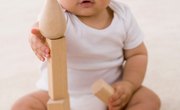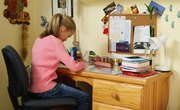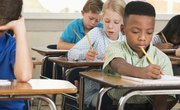Child observations provide teachers, school administrators and parents with the chance to assess a young student's strengths, areas for improvement and overall development in a natural environment. Writing an observation report is a process that starts with actively watching the child, taking notes and putting the data together into a usable assessment.
Setting the Stage
Before you begin the observation, you'll need to decide where and when you plan on watching the child. The setting depends on what information you're trying to obtain. For example, if you want to assess the child's social development you may want to choose a free-play period at preschool. If you're a teacher, conducting a focused observation while still trying to work with the class as a whole may seem challenging. You may want to have someone else on hand to help out with your other tasks while you watch the child in her natural school setting. Choosing a time frame and time of day can contribute to what you see and help you to get the data that you're looking for. If you're observing the child over time you'll want to choose between regular intervals or different times of the day.
Notable Notes
Simply watching the child isn't enough to eventually write a credible report. It's likely that after your observation you won't remember every specific detail or may not feel clear about what you actually saw. Solve this dilemma by taking detailed notes. While you don't have to write down every single thing that the child does or says, you can use an "Antecedent-Behavior-Consequence" model as suggested by the NAEYC for Families website. If you're looking for a particular behavior or to better understand why a child is acting out, write down notable incidents, how the child reacted and what happened afterward. For example, if Johnny won't stop biting other children, note that another boy took his toy, he bit the child and then the teacher removed him from the room.
Put It Together
You've made your observations, taken notes along the way, and now you're ready to review your data and turn it into one report. Review your notes and analyze what the child did, when the events occurred and the overall context. Doing so can help you to evaluate the child's behavior and development. Turn your notes into a narrative that describes the child in terms of what the assessment is looking for. For example, if you're evaluating a child's self-control ability, you'll want to write about the observed instances when she either could or couldn't control herself. This might include a description of her attention and focus during storytime or how she controlled her body movements during the physical education period.
Find a Format
A key piece of writing the observation report is formatting it. Craft a clear picture of the observation that includes the specifics. State the reason, objective or need for the observation. Create time and setting headings with the examples underneath. Add in information on who else was present during the observation, such as the parents, a teacher or other students. Start with the specific activity that you observed, and then elaborate with a narrative on what the child did, said and any interactions with other people. Integrate applicable child development theory and research into the observation example text. Include information on what the assessment means or a plan of action to improve any problem areas.
Related Articles
References
Writer Bio
Based in Pittsburgh, Erica Loop has been writing education, child development and parenting articles since 2009. Her articles have appeared in "Pittsburgh Parent Magazine" and the website PBS Parents. She has a Master of Science in applied developmental psychology from the University of Pittsburgh's School of Education.











